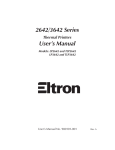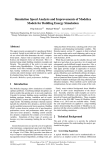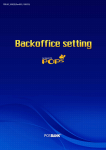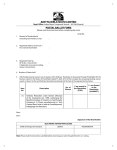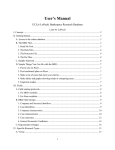Download Small Business Plan Tool User Manual
Transcript
Small Business Plan Tool User Manual Prepared by: S-BizT Team (http://www.smallbizplantool.com) Powered by: MBM Consulting (http://mbm-consulting.com/) Prepared by S-BizT team (http://www.smallbizplantool.com) Powered by MBM-Consulting (http://mbm-consulting.com/) List of Acronyms and Abbreviations S-BizT : A financial model to obtain financial projections of a company. The word “S-BizT” is exchangeable to “financial model” or “spreadsheet” or “model” DCF : Discounted Cash Flow DLOC : Discount Lack of Control DLOM : Discount Lack of Marketability KD : Cost of Debt KE : Cost of Equity Prepared by S-BizT team (http://www.smallbizplantool.com) Powered by MBM-Consulting (http://mbm-consulting.com/) Introduction 1.1. Overview This user’s manual is a step-by-step guidance to use a Small Business Planning Tool or S-BizT. By following through this user’s manual, user will have a clear idea on how this financial model works and how to plan their business financial projection appropriately. 1.2. Purpose of the S-BizT S-BizT is an MS Excel based tool, created to perform financial projection of a business. By inputting projection assumptions, users can plan on how to run their business well. Not all type of businesses can be planned using S-BizT as different type of businesses requires different elements of revenue and cost generators, as well as its accounting treatment. S-BizT fits for planning several business types, as follows: Manufacturing Retail store Trading S-BitzT Financial Modeling Best Practices 2.1. Requirements under S-BizT Best Practices for Financial Modelling S-BizT is developed based on MS Excel 2010, employing best practice standards to the extent possible given the complexity of the transaction and the various input assumptions. Among others, in compliance with S-BizT best practices for financial modeling, the following steps were taken: Separation of worksheets containing input worksheets (for historical data and assumptions), calculation worksheets and output worksheets Complex, nested functions are avoided and minimization of use of macros Reduction/eradication of circular calculation thus avoiding circular reference problems Password-protected to ensure security of data Logical flow – from top to bottom, left to right (within worksheets and across workbook) Financial Model Structure & Worksheets 3.1. User’s Manual Approach In order for the user to easy in understanding how the model works, S-BizT team has prepopulated the assumptions worksheets with dummy numbers. The company provided is an imaginary company. 3.2. Worksheet Classification In general, each worksheet has been categorized as follows: Input Worksheets: input assumptions entered on these worksheets represent inputs to the financial model. Prepared by S-BizT team (http://www.smallbizplantool.com) Powered by MBM-Consulting (http://mbm-consulting.com/) For ease of use/access, these worksheets are light brown color coded tabs, in which input assumptions among others relating to historical data and assumptions are entered and indicated in light brown color coded cells. In order to maintaining the model integrity, mathematically correctness as well as user-friendliness of the spreadsheet, only cells with light brown color coded are accessible. All assumptions are inputted via the Input Worksheets. Calculation Worksheets: calculations are made on the inputted assumptions in order to derive an output. Calculation Worksheets are used to avoid complex nested functions and macros. The calculations worksheets are hidden to maintaining the model integrity and to avoid any mathematical error within the financial model. Output Worksheets: outputs of the financial model, based on the calculations made on the input assumptions, are presented here. These worksheets tab are highlighted in dark grey, which provides full financial statements (income statement, balance sheet and cash flow statement), break even calculation result and financial ratios of the company 3.3. Worksheet List A list of worksheets and their functions is tabulated below in the sequence in which they are currently found in the financial model. No Worksheet Function or Purpose 1 Opening Provides information such as Disclaimer Agreements 2 Menu Provides summary contents for all sheets contain in the spreadsheet and a concise tutorial 3 Dashboard Provides graphical presentation of all of the financial ratios and snapshots of income statement & balance sheet for the selected year generated by the financial model 4 InputSection > Separation sheet between opening sheets section and input sheets section. 5 HistoricalFS Input sheet for actual historical data of balance sheet and income statement. 6 BaseCaseAssumptions Input sheet for your operating, capital expenditures and financing activities assumptions as your base case scenario. 7 HighCaseAssumptions Input sheet for your operating, capital expenditures and financing activities assumptions as your high case scenario. 8 LowCaseAssumptions Input sheet for your operating, capital expenditures and financing activities assumptions as your low case scenario. Prepared by S-BizT team (http://www.smallbizplantool.com) Powered by MBM-Consulting (http://mbm-consulting.com/) No Worksheet Function or Purpose 9 Valuation An input as well as an output sheet for calculating and presenting business (or company) value and equity value 10 OutputSection > Separation sheet between input sheets section and output sheets section. 11 FS Output sheet for historical and projected income statement, balance sheet, and cash flow statement. 12 BreakEven Output sheet for breakeven of Sales calculation result in term of certain currency (in USD, £, ¥, etc.) depending on the user’s currency selection in the general assumptions sheet. 13 Ratios Output sheet for a broad range of financial ratios. 14 RatiosBaseCase Output sheet for a broad range of base case financial ratios results from your base case assumptions input. 15 RatiosHighCase Output sheet for a broad range of high case financial ratios results from your high case assumptions input. 16 RatiosLowCase Output sheet for a broad range of low case financial ratios results from your low case assumptions input. 17 AllRatios Output sheet for a broad range of all cases financial ratios that would assist you in comparing the results of ratios from all cases. Prepared by S-BizT team (http://www.smallbizplantool.com) Powered by MBM-Consulting (http://mbm-consulting.com/) Opening 4.1 Menu & Tutorial This worksheet provides summary contents for all sheets contain in the spreadsheet and a concise tutorial on how to use S-BizT. 4.2 Dashboard This worksheet provides graphical presentation of all of the financial ratios and snapshots of income statement & balance sheet generated by the financial model. Prepared by S-BizT team (http://www.smallbizplantool.com) Powered by MBM-Consulting (http://mbm-consulting.com/) Using S-BizT 5.1 Historical Data The only sheets user can put in numbers are sheets with light brown color coded tabs (HistFS, BaseCaseAssumptions, HighCaseAssumptions, LowCaseAssumptions and Valuation). User can only put in numbers in the light brown color coded cells. This is to maintain a user friendliness of the model. The provided numbers in the model are for illustration only; user has to remove the unnecessary numbers and put in user’s historical financial statements numbers accordingly. What user needs to do are : 1. 2. Enter the company/business name at the provided cell as pointed by the arrow at the picture bellow. Continue with entering the business historical financial statements. User only can input this historical financial statements cells if user has historical financial statements. If that is not the case, then just leave all the light brown color coded cells empty. Prepared by S-BizT team (http://www.smallbizplantool.com) Powered by MBM-Consulting (http://mbm-consulting.com/) 5.2 Assumptions – Base Case Scenario Assumptions sheet is where user has to put in numbers to project your company’s financial statements. Assumptions sheet consists of: A. B. C. D. E. F. G. H. I. J. General assumptions Operating assumptions Other income/ expense assumptions Tax assumptions Dividends assumptions Other balance sheet items assumption Capital expenditure assumptions Equity/ owner’s capital assumptions Short term loan assumptions Long term loan assumptions Details on each item will be explained in section 5.2.2 up to 5.2.10 in this User Manual. 5.2.1 Projection Period S-BizT allows user to project their company financial on monthly basis for the first year projection and yearly basis up to 10 years. The years of the period depend on the Projection Start Date the user input in the following section. 5.2.2 General Assumptions Put in the Projection Start Date and the type of Currency. The financial model will automatically calculate your latest historical financial statements date. The Currency you input will be used throughout the SBizT. Prepared by S-BizT team (http://www.smallbizplantool.com) Powered by MBM-Consulting (http://mbm-consulting.com/) 5.2.3 Operating Assumptions Sales In projecting Sales user can choose the input calculation method options, which are Input Method or Growth Method, and subsequently S-BizT will calculate it accordingly. S-BizT allows user to plan selling up to 5 products, but if user has more than 5 products, user can input it under Other Products. However user has to ensure that user has calculated it on average basis beforehand. User can always calculate any data in spare worksheets before incorporat ing it into the assumptions sheets. Add any of the spare worksheets whenever you need it. Put in each of your product names in the provided cells. The provided numbers in the model are for illustration only; user has to remove the unnecessary numbers and put in the assumption numbers for each post (PRICE, VOLUME, SLAES GROWTH, and AVERAGE DAYS RECEIVABLE) accordingly. During the course, press the “Base Case” button regularly to check your Ending Cash Balance as presented in row 7. Prepared by S-BizT team (http://www.smallbizplantool.com) Powered by MBM-Consulting (http://mbm-consulting.com/) Cost of Goods Sold (COGS) & Inventory In projecting COGS user can choose one of the input calculation method options, which are Input Method or Gross Margin Method, subsequently S-BizT will calculate it accordingly. S-BizT allows user to plan COGS up to 5 products as well as Other Products related to the Sales assumptions user has input beforehand. For the Other Products, user has to ensure that user has calculated it on average basis beforehand. You can always calculate any data you have in spare worksheets before you incorporate it into the assumptions sheets. Add any of the spare worksheets whenever you need it. Average Days Payable is your company payables turnover in number of days unit. Average Days Inventory is your company inventories turnover in number of days unit. Average Days Accrued Expense is your company accrued-expenses turnover in number of days unit. During the course, press the “Base Case” button regularly to check your Ending Cash Balance as presented in row 7. Prepared by S-BizT team (http://www.smallbizplantool.com) Powered by MBM-Consulting (http://mbm-consulting.com/) Operating Expenses Operating Expenses consists of General Administrative, Personnel, Insurance, Transportation and Other Operating Expenses. In projecting Operating Expenses user can choose one of the input calculation method options, which are Input Method or Gross Margin Method, subsequently S-BizT will calculate it accordingly. During the course, press the “Base Case” button regularly to check your Ending Cash Balance as presented in row 7. Prepared by S-BizT team (http://www.smallbizplantool.com) Powered by MBM-Consulting (http://mbm-consulting.com/) 5.2.4 Other Income/ Expense Put in numbers for Other Income and Other Expense accordingly in the provided cells. Ensure that you have calculated the aggregated Other Income and Other Expense beforehand. You can always calculate any data you have in spare worksheets before you incorporate it into the assumptions sheets. Add any of the spare worksheets whenever you need it. 5.2.5 Tax and Dividends Put in numbers for Income Tax Rate, Tax Payable Days and Dividend Payout Ratio accordingly in the provided cells. Prepared by S-BizT team (http://www.smallbizplantool.com) Powered by MBM-Consulting (http://mbm-consulting.com/) 5.2.6 Other Balance Sheet Items Since Other Balance Sheet are usually non-substantial items, therefore projecting them in a certain manner is not common, hence they will be projected automatically by the model the same amount as the last position in the previous period. 5.2.7 Capital Expenditure Prepared by S-BizT team (http://www.smallbizplantool.com) Powered by MBM-Consulting (http://mbm-consulting.com/) Capital Expenditure consists of Existing Fixed Assets and New Fixed Assets. Each of them consists of Buildings, Machineries and Equipment. For Existing Fixed Assets, user has to input the aggregate book value of each type of asset , overall economic useful life and its remaining useful life. For New Fixed Assets, user has to input the purchasing plan of each type of asset During the course, press the “Base Case” button regularly to check your Ending Cash Balance as presented in row 7. 5.2.8 Equity/ Owner’s Capital Paid in Capital under Equity/ Owner’s Capital section is where if the owner of the company injecting (more) money into the company from their own pocket. Prepared by S-BizT team (http://www.smallbizplantool.com) Powered by MBM-Consulting (http://mbm-consulting.com/) 5.2.9 Short Term Loan Along with the growing of the company, operating activities are increasing as well, and the common consequence is the company experiences short of working capital (short of cash to operate the company). Short Term Loan is where user can plan their working capital loan due to the need for additional working capital. Each of Short Term Loan item is for a single loan facility. On the sample above the company already has a single US$ 17,000 outstanding of Short Term Loan facility from the previous period. If the company has more than one Short Term Loan facility, therefore you have to put in the loan amount accordingly. They fall under the cells of the SHORT TERM LOAN OUTSTANDING post. User can also put in additional loan facilities/ amounts into the cells under the SHORT TERM LOAN DRAWDOWN post if the company need more fund. If you see your company has excess cash, therefore you can repay the loan into the cells under the SHORT TERM LOAN REPAYMENT post. Put in the INTEREST RATE accordingly During the course, press the “Base Case” button regularly to check your Ending Cash Balance as presented in row 7. Prepared by S-BizT team (http://www.smallbizplantool.com) Powered by MBM-Consulting (http://mbm-consulting.com/) 5.2.10 Long Term Loan Long Term Loan is where the company borrow money with the purpose of to fund the company’s investment in Fixed Assets, i.e. Buildings, Machineries and Equipment. While land is usually funded by the equity of the company. Each of Long Term Loan item is for a single loan facility. On the sample above the company already has a single US$ 20,000 outstanding of Short Term Loan facility from the previous period. If the company has more than one Long Term Loan facility, therefore you have to put in the loan amount accordingly. They fall under the cells of the LONG TERM LOAN OUTSTANDING post. Loan to equity ratio is vary from 70:30, 80:10 or other ratios depending on the company negotiation with the bank User can also put in additional loan facilities/ amounts into the cells under the LONG TERM LOAN DRAWDOWN post if you need more fund. Put in the INTEREST RATE accordingly Long Term Loan is reduced according to loan repayment schedule based on the company’s cash availability for debt services. During the course, press the “Base Case” button regularly to check your Ending Cash Balance as presented in row 7. Prepared by S-BizT team (http://www.smallbizplantool.com) Powered by MBM-Consulting (http://mbm-consulting.com/) 5.3 Assumptions – High Case & Low Case Scenarios High Case Assumptions and Low Case Assumptions are other assumptions input for different scenarios, depending on the business nature of your particular company. The way to input their assumptions is the same with the way with how to put in assumptions in Base Case scenario, except the GENERAL ASSUMPTIONS part, where they are already linked to the base case scenario assumptions sheet. During the course, press the “High Case” or “Low Case” buttons regularly to check your Ending Cash Balance as presented in row 7. 5.4 Valuation Investors and banks usually need to know how much your business is worth; therefore S-BizT provides a valuation calculation sheet. The Valuation sheet is where you can calculate your business (company) and company’s equity value using the DCF method. Prepared by S-BizT team (http://www.smallbizplantool.com) Powered by MBM-Consulting (http://mbm-consulting.com/) Input all of the assumptions in the provided cells in light brown color coded accordingly. User might need helps from an experienced person in inputting all the assumptions in this Valuation sheet After inputting the assumptions above, you will get your overall company’s and company’s equity values. Outputs 6.1 Description The output worksheets in the financial model are the result of calculating all the numbers inputted in the assumptions worksheets. 6.1.1 Financial Statements Prepared by S-BizT team (http://www.smallbizplantool.com) Powered by MBM-Consulting (http://mbm-consulting.com/) FS worksheet is where you can find Income Statement, Balance Sheet and Cash Flow Statements, both for historical data and financial projections as the results of calculations of inputted assumptions. 6.1.2 Break Even Point BreakEven worksheet is an output sheet for amount of breakeven of Sales calculation result in term of certain currency (in USD, £, ¥, etc.) depending on the user’s currency selection in the general assumptions sheet. 6.1.3 Financial Ratios Prepared by S-BizT team (http://www.smallbizplantool.com) Powered by MBM-Consulting (http://mbm-consulting.com/) Ratios worksheet is an output sheet for a broad range of financial ratios. It consists of profitability ratios, management efficiency ratios, liquidity & leverage ratios, EBITDA and EBITDA related ratios, capital structure ratios, cash flow summary and valuation summary. At the top side of the worksheet, there are DUPONT ratios as a summary of financial ratios calculated beneath. Aside from Ratios worksheet, there are RatiosBaseCase, RatiosHighCase, RatiosLowCase and AllRatios worksheets, where each of those sheet presenting financial ratios for each case. AllRatios worksheet is where all cases of financial ratios presented. Prepared by S-BizT team (http://www.smallbizplantool.com) Powered by MBM-Consulting (http://mbm-consulting.com/) Disclaimer The Financial Model (the “Model” or “S-BizT”) has been prepared by MBM Consulting Services (“MBM”). This model is not intended to be used in evaluation of any project, transactions or investments. Acceptance by a Recipient of the Model constitutes its agreement to, and acceptance of, each of the terms and conditions set forth in this agreement. None of MBM, nor its Affiliates accepts liability or responsibility for the adequacy, accuracy or completeness of; or makes any representation or warranty, express or implied, with respect to the information contained in this Model or on which this Model is based or any other information or representations supplied or made in connection with this Model or as to the reasonableness of any projections contained in this Model. MBM does not provide any assurance that the Model is free from errors to any recipients of the Model. The recipients are responsible for conducting their own tests and assessments on the Model to ensure that it is free from errors. This Model has been designed so the user can change some of the assumptions and other relevant data inputs in order to consider alternative outcomes. The model has limits and may not produce valid results for all possible combinations of input data; errors and potential errors may thus go unnoticed. MBM is not responsible for inaccuracies, failure of the model or calculation errors due to the user’s input or inadequacies. This Model may include certain forward-looking statements, estimates and projections of anticipated future performance for illustration purposes only. No liability to any person is accepted by MBM and its Affiliates in relation to the distribution of this Model in any jurisdiction. The Model is provided by electronic means (such as Internet, emails or other media devices). MBM does not guarantee that the file is free from computer viruses or other factors which may affect the integrity of the electronic file or the system which receives it. In this agreement, “Affiliates” means in relation to any person, its holding companies, companies under the control of such holding companies, and subsidiaries and its respective directors, officers, employees and agents or any other person that is controlled by, controls or is under common control with any of the foregoing persons. For the avoidance of doubt, by opening this file, the user is by default, unconditionally accepting all of the above terms. Prepared by S-BizT team (http://www.smallbizplantool.com) Powered by MBM-Consulting (http://mbm-consulting.com/)






















